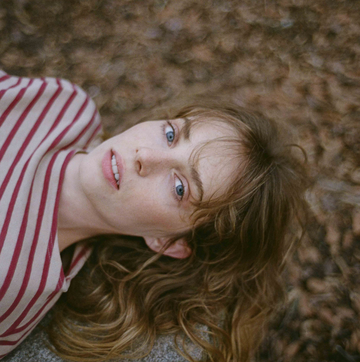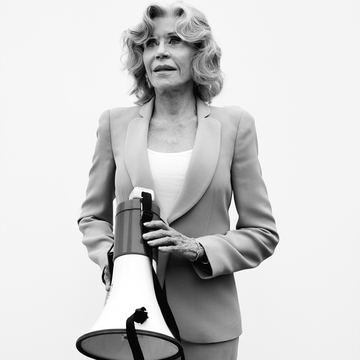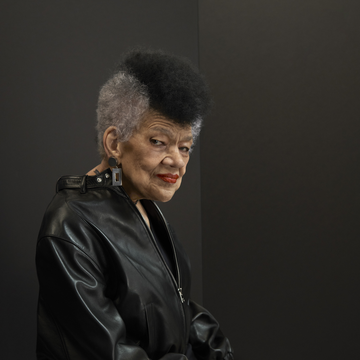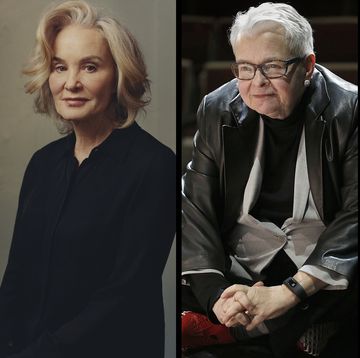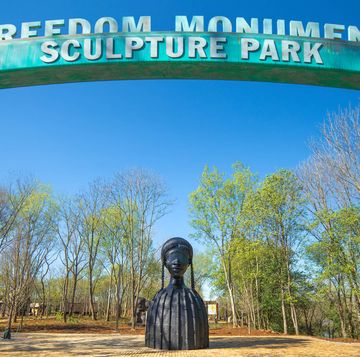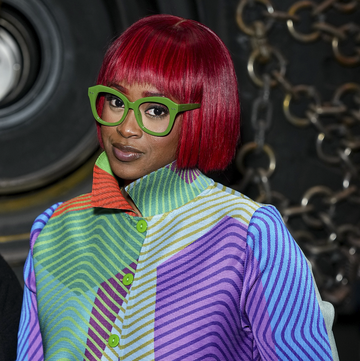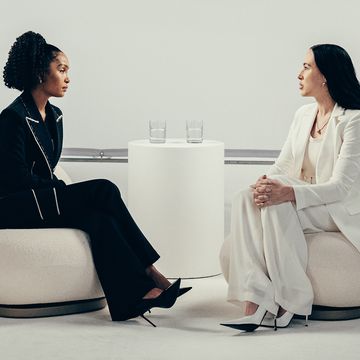"You gotta have style. It helps you get down the stairs. It helps you get up in the morning. It's a way of life. Without it, you're nobody." So said legendary BAZAAR editor and fashion arbiter Diana Vreeland. She would know better than anyone else. A gleeful iconoclast and daringly original thinker, she cultivated a striking sense of personal style in response to the damning verdict of her beautiful and reckless socialite mother, Emily Hoffman Dalziel. "I was always her ugly little monster," said Vreeland. And so, at a very young age, Vreeland realized that only her taste and vision could set her apart.
Instead of concealing her so-called flaws, as she grew up, Vreeland transformed them into a mark of her elegance by emphasizing them. She cropped her black hair and wore it back to reveal her severe profile and set off her pale skin with rouged cheekbones and scarlet fingernails.
Through sheer will and a disciplined study of all things sartorial, literary, and artistic, Vreeland became a force that dared observers not to notice. And during her 26 years as the fashion editor of BAZAAR, from 1936 to 1962, she constantly proselytized her personal mantra: "Style: All who have it share one thing — originality."
When I married Vreeland's grandson Alexander Vreeland in 2000, I entered her most intimate circle: her family. Although I never met her (she died in 1989), it was impossible not to become entrenched in her life. Her family's stories were peppered with hilarious accounts of their life with her and her illustrious career. But it wasn't until I started to conduct research for my book and documentary film, legendary Diana Vreeland: The Eye Has to Travel, that I felt I had finally discovered her real world and what drove her. Her career spanned six decades and witnessed major social upheavals and changes: World War II, the space age, and the sexual revolution. She made sure these events were reflected on the pages of Bazaar in ways that were considered shocking at times but were always innovative, vibrant, and unforgettable.
Vreeland began to develop her viewpoint at a young age, but it was when she married handsome Yale graduate and international banker T. Reed Vreeland that she finally became secure with her appearance. "I never felt comfortable about my looks until I married Reed Vreeland. I believe in love at first sight because that's what it was. I knew the moment our eyes met that we would marry," she said. "I could never have lived except with Reed. He used to teach me everything," including how to walk elegantly.
A few years after they wed, in 1924, he whisked her away to London, where they launched the life she'd always dreamed of, brimming with dinners, parties, and trips to exotic locales. The door to their house was painted in Vreeland's preferred red, all the better to shock the neighbors with. She opened a lingerie boutique where Wallis Simpson, soon to be the Duchess of Windsor, was a client. And as Vreeland said, "The best thing about London is Paris," where she traveled regularly for fittings with Coco Chanel herself.
By then, she had become the mother of two sons, Timothy and Frederick — my father-in-law, who she dubbed Frecky — who remember their mother only as an alluring creature. "[My first memories are of] Mom floating through the room, dancing the rhumba with her teacher," Tim told me.
Indeed, it was her dancing skills that first caught the eye of then-BAZAAR editor in chief Carmel Snow. It was a night at the St. Regis Hotel in New York, and Vreeland stood out from the frolicking crowd in her favorite white lace Chanel dress, her lacquered blue-black hair adorned with matching white roses. An enchanted Snow offered her a job the next day.
"But Mrs. Snow," Vreeland recounted in her autobiography, D.V., "except for my little lingerie shop in London, I've never worked. I've never been in an office in my life. I'm never dressed until lunch." "But you seem to know a lot about clothes," said Snow. Vreeland replied, "That I do. I've dedicated hours and hours of very detailed time to my clothes."
It was a tempting proposal. Vreeland had been back in New York only six months, but she needed the money in order to continue the extravagant lifestyle to which she and Reed had become accustomed while in London. She decided to accept Snow's offer and soon joined legendary art director Alexey Brodovitch at the magazine for what would be decades of intense collaboration and groundbreaking fashion.
Vreeland immediately launched her "Why Don't You…?" column on the pages of BAZAAR. These aphoristic musings — which to me made Vreeland the first blogger — coaxed readers out of their quotidian existence and dared them to dream. "Why don't you…paint a map of the world on all four walls of your boys' nursery so they won't grow up with a provincial point of view?" she suggested, or "Why don't you…wash your blond child's hair in dead champagne, as they do in France?" or, most extravagantly, "Why don't you…own, as does one extremely smart woman, 12 diamond roses of all sizes?" Such ideas were met with both adulation and derision by her audience. Nevertheless, they set the tone for the rest of Vreeland's career, in which she invited her audience to accompany her on a great adventure that was made up of all the experiences a life well lived could bring.
"A new dress doesn't get you anywhere; it's the life you're living in the dress, and the sort of life you had lived before, and what you will do in it later," she said, but it was a philosophy she had always espoused. Soon BAZAAR began to reflect the knowledge and flair for fashion that Vreeland had collected in her younger years. Her pages portrayed "the HB look" and exhorted readers to wear bolder hues or to "take an idea from Africa," showing a model with a white-and-black elephant-printed jacket kneeling on a white-and-black-spotted fur rug. "Fashion must be the most intoxicating release from the banality of the world," she declared.
She roused her audience to new heights: "If it's not there in fashion, fantasize it," she said. Vreeland was such an unconventional thinker that at one point she wanted to trade in pocketbooks for pockets. ("What do I want with a bloody old handbag that one leaves in taxis?" she explained to George Plimpton, who conducted the interviews for D.V. years later.)
Vreeland may have always had a chauffeured car idling at the ready and worn custom-made T-strap heels whose soles were polished every night by her ladies' maid, but she was a hard worker and expected everyone to keep up. She always kept the habit of her late start, often working out of her red-lacquered Upper East Side apartment all morning, but once she was at the office, it was full steam ahead. Lunch was typically nothing more than a peanut butter and jelly sandwich on whole-wheat bread at her desk, washed down with the obligatory scotch, and then it was right back to dictating memos. "We saw every corset, every belt buckle, every piece of new cloth," she said. "We felt the rhythm, the music, the whole tango. One was editor of all clothes."
While Vreeland was becoming a singular presence at the magazine, outside the office she and Reed maintained an equally vigorous social life. Weekends were spent in Brewster, New York, where the guests they entertained in their double-height shocking-pink living room — with a mantelpiece made of shells — included designers like Mainbocher, Elsa Schiaparelli, Fulco de Verdura, Jean Schlumberger, and Cartier's Jeanne Toussaint, along with actors and writers. In town, it was everyone from Cecil Beaton to C.Z. Guest. Their life was a fable, full of the most interesting characters of the age, and it was Reed who quickly took on the role of homemaker. (When he passed away in 1966, Vreeland went back to their Park Avenue apartment, looked around, and asked, "Where is the kitchen?")
Though their sons, Tim and Frecky, were often left to be raised by nannies and governesses, Vreeland took great care that they were exposed to every culture, religion, and race. "The world had no borders in her mind," says Frecky. "I was brought up with that, and it became the cornerstone of my life." Vreeland's own travels informed her styling. She was responsible for featuring the first bikini in the magazine, in 1947, after spotting one during a trip to the French Riviera. "She put it on [the] model, and we were all in her office, and we were all dazed, you know. We'd never seen such exposure of skin," remembers her former assistant Barbara Slifka of the scene caused by such immodest attire. "And she said, 'With an attitude like that, you keep civilization back [a] thousand years.'"
Vreeland also famously cast Lauren Bacall as an American Red Cross girl for Bazaar's iconic March 1943 cover, shot by her frequent collaborator Louise Dahl-Wolfe. (It was Bazaar that launched Bacall in Hollywood. When director Howard Hawks's wife showed her husband a picture of Bacall in the magazine, he immediately called her and cast her in To Have and to Have Not the following year.) Throughout the war, Vreeland and Dahl-Wolfe worked together to create seminal images that didn't shy away from the news of the day, including a fashion shoot using newspapers clearly emblazoned with the headline NAZIS. And both were addicted to rich tones. Dahl-Wolfe was one of the first to photograph in color film on location, which the duo exploited to full effect.
Nothing held Vreeland back. She was always ready to leap into action. For one shoot, she and Dahl-Wolfe made the pilgrimage to Arizona to shoot a resort fashion story at architect Frank Lloyd Wright's Shiprock. Once they were there, however, one of the models for the portfolio fell ill, so Vreeland herself took her place, which, given the extent of the control she enjoyed exerting, may have been an outcome she particularly relished.
Vreeland had very clear ideas about what she wanted photographed and how she wanted it to be done. She considered the photographer a vehicle to convey her message, fashion, to the readers. It was Brodovitch who inspired and liberated photographers and Vreeland who gave them the taste for luxury and adventure. Gesture and attitude were important to her, as was strength of character, not only in the face but in the mind as well. And imagination trumped it all. "She made the look, Brodovitch made those portraits of look flow through the book, Snow took care of upstairs and Seventh Avenue," the late photographer Gleb Derujinsky told me.
Glancing through issues of Bazaar, one cannot help noticing the inventory of renowned photographers with whom Vreeland worked. In addition to Dahl-Wolfe and Derujinsky, there was George Hoyningen-Huene, Martin Munkacsi, Toni Frissell, Melvin Sokolsky, Lillian Bassman, and, of course, Richard Avedon.
Though Avedon and Vreeland became names as intertwined as Fred and Ginger, they nearly did not work together at all. Avedon was merely an up-and-coming photographer when Snow assigned him to work with Vreeland in 1945. Their first real introduction, during a fitting, hardly went well. "[Vreeland] took one pin and walked, swinging her hips, down the narrow office to the end. She stuck the pin not only into the dress but into the girl, who let out a little scream," Avedon remembered in his 1989 eulogy for her. "Diana returned to her desk and looked up at me for the first time and said, 'Aberdeen, Aberdeen, doesn't it make you want to cry?' Well, it did. I went back to Carmel Snow and said, 'I can't work with that woman. She calls me Aberdeen,' and Carmel Snow said to me, 'You are going to work with her,' and I did, to my enormous benefit, for almost 40 years."
Theirs was a partnership that created monumental, iconic images. Together, they shot supermodels such as Dovima in locations as outlandish as an air-force missile-testing center and convinced Vreeland's society friends, including Marella Agnelli, Gloria Vanderbilt, and Jacqueline de Ribes, to sit for rare portraits. And in the ultimate coup, they portrayed the young Kennedy family a mere three weeks before John F. Kennedy was sworn in as president. Jacqueline Kennedy wrote to Vreeland after it was published: "I was furious today when I read Newsweek on how everyone is wondering why we chose Harper's Bazaar, and they invent a million reasons and no one says the real one — which is you."
In his eulogy, Avedon said of Vreeland, "Diana lived for imagination ruled by discipline and created a totally new profession. She invented the fashion editor. Before her, it was society ladies who put hats on other society ladies." Her pages marked a revolution in editorial style that spread throughout the fashion industry.
"Mom was the person who invented allure," Frecky told me. "Allure is something different from the conventionality of beauty. There's something frozen about a convention by definition, and she was against anything that was frozen."
In her aptly titled 1980 book, Allure, Vreeland wrote, "The eye has to travel," and, yes, so it does. I could not help giving my book and documentary film that phrase as a title. This simple sentence reveals how Vreeland thought and how she perceived the world. Through her trained and diligent eye, she opened the door of our minds and encouraged us to be free, to see, and to imagine. She taught us to look at things in a different manner and allowed fantasy to play a dominant role. She dared everyone to live in a more provocative fashion. There have been many influential fashion figures throughout time, but few have been as consistent as Diana Vreeland in vision, passion, and point of view.
Lisa Immordino Vreeland's book, Diana Vreeland: The Eye Has to Travel, will be published October 1.





